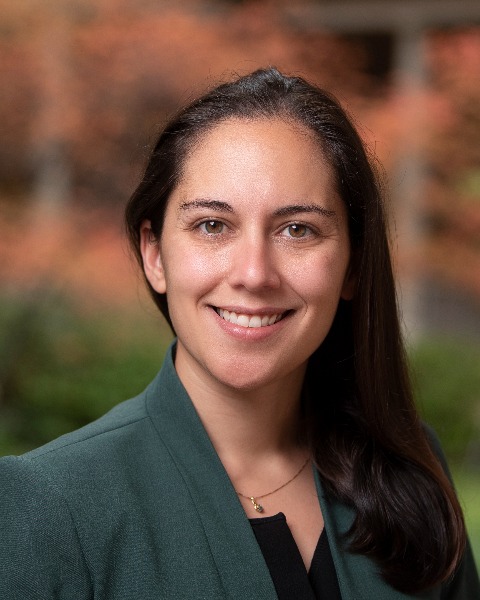Women's Health
(M-483) Immune-Senescence Communication Networks in Fibroids

Joscelyn Mejias, PhD (she/her/hers)
Postdoc Fellow
Johns Hopkins University
Baltimore, Maryland, United States- HN
Helen H. Nguyen
Research Technologist
Johns Hopkins University, United States - SN
Sushma Nagaraj
Instructor
Johns Hopkins University, United States - ME
Malak El Sabeh, MD
Research Fellow
Johns Hopkins University, United States - SA
Sadia Afrin, PhD
Postdoctoral Fellow
Johns Hopkins University, United States - AR
Anna Ruta
Graduate Student
Johns Hopkins University, United States - KK
Kavita Krishnan
Graduate Student
Johns Hopkins University, United States - KS
Katlin Stivers, PhD
Research Immunologist
Johns Hopkins University, United States - NR
Natalie Rutkowski
Graduate Student
Johns Hopkins University, United States - CC
Christopher Cherry, PhD
Consultant
C M Cherry Consulting, United States - MB
Maria Browne
Research Technologist
Johns Hopkins University, United States - MI
Md Soriful Islam, PhD
Research Fellow
Johns Hopkins University, United States - EF
Elana Fertig, PhD
Professor
Johns Hopkins University, United States - MB
Mostafa Borahay, MD, PhD
Associate Professor
Johns Hopkins University, United States - JS
James Segars, MD
Professor
Johns Hopkins University, United States - JE
Jennifer Elisseeff, PhD
Professor
Johns Hopkins University, United States
Presenting Author(s)
Co-Author(s)
Last Author(s)
Materials and Methods:: Fresh surgical fibroid (and when possible, patient-matched myometrium) samples were collected through approved IRB protocols. When possible, patient matched fibroids and myometrium were examined. Tissues samples were subsampled for immunofluorescent (IF) staining (paraffin embedding) or single cell suspensions. For flow cytometry and single cell RNA sequencing (scRNAseq), samples were processed with mechanical (cut into 1mm pieces) and enzymatic (Collagenase/DNase) dissociation. To ensure the immune compartment was fully captured for sequencing, we enriched for CD45+ using magnetic bead sorting then mixed CD45+ to CD45- cell fractions at a 1:1 ratio. Cells were sequenced using 10x 3’ and sequencing data was aligned with CellRanger 6.0.1 (10x Genomics). Gene expression analysis was performed with the Seurat package [2] in R, while the projectR package [3] was utilized to apply signatures to the scRNAseq data set.
Results, Conclusions, and Discussions::
Quantification of IF staining of myometrium (Myo) and fibroids (Fib) for p16 (senescence, red), CD68 (myeloid, yellow), CD31 (endothelial, green), and DAPI (nuclear, white) revealed a significant increase of senescent cells within fibroids, Fig 1A-B. Flow cytometry was used to study the immune cells within patient-matched myometrium and fibroids. T cells (CD3+) significantly increased while granulocytes (CD15+) decreased in fibroids as a fold-change proportion relative to patient-matched myometrium, Fig 1C. To study the immune-senescence communication pathways, scRNAseq samples were collected which revealed diverse stromal and immune cell populations, Fig 1D. We predicted cellular senescence by applying SenSig, an in vivo derived senescence signature [4] using the projectR [3] method, Fig 1E. The resulting SenSig scores (projection weight) predict a subset of senescent cells within the fibroblasts, smooth muscle cells, pericytes, lymphatic endothelial and in one of the endothelial populations, Fig 1F. Since senescent cells are characterized by their SASP, we analyzed the secreted ligands between the SenSig score+ and SenSig score- cells within these populations. Several genes related to the extracellular matrix and vasculogenesis were upregulated within the predicted senescent cells, Fig 1G.
There was a significant increase in senescence within uterine fibroids relative to patient-matched myometrium, as well as shifts in proportions of immune populations. Flow cytometry and scRNAseq analysis reveals heterogenous cell populations between fibroids and myometrium. Application of a senescent signature predicted senescent cells within several of these populations. We have identified unique secreted ligands between the predicted senescent cells and multiple other cell types that may represent an avenue for new therapeutic targets. Future work using computational algorithms such as Domino [5] to infer cell communication networks between predicted senescent cells and immune populations in the fibroid and myometrium will advance understanding of senescence – immune crosstalk in uterine fibroids.
Acknowledgements (Optional): : Morton Goldberg Chair, Bloomberg Kimmel Institute for Cancer Immunotherapy, NIH Pioneer (DP1AR076959) to JHE and NICHD grant R01HD094380 to MAB and JS, R01HD111243 to JS, MAB, JHE. JCM is funded by K99AG081564.
References (Optional): :
[1] Baird DD, Dunson DB, Hill MC, Cousins D, Schectman JM. High cumulative incidence of uterine leiomyoma in black and white women: ultrasound evidence. Am J Obstet Gynecol. 2003 Jan;188(1):100-7. doi: 10.1067/mob.2003.99. PMID: 12548202.
[2] Hao Y, Hao S, Andersen-Nissen E, Mauck WM 3rd, Zheng S, Butler A, Lee MJ, Wilk AJ, Darby C, Zager M, Hoffman P, Stoeckius M, Papalexi E, Mimitou EP, Jain J, Srivastava A, Stuart T, Fleming LM, Yeung B, Rogers AJ, McElrath JM, Blish CA, Gottardo R, Smibert P, Satija R. Integrated analysis of multimodal single-cell data. Cell. 2021 Jun 24;184(13):3573-3587.e29. doi: 10.1016/j.cell.2021.04.048. Epub 2021 May 31. PMID: 34062119; PMCID: PMC8238499.
[3] Stein-O'Brien GL, Clark BS, Sherman T, Zibetti C, Hu Q, Sealfon R, Liu S, Qian J, Colantuoni C, Blackshaw S, Goff LA, Fertig EJ. Decomposing Cell Identity for Transfer Learning across Cellular Measurements, Platforms, Tissues, and Species. Cell Syst. 2019 May 22;8(5):395-411.e8. doi: 10.1016/j.cels.2019.04.004. Erratum in: Cell Syst. 2021 Feb 17;12(2):203. PMID: 31121116; PMCID: PMC6588402.
[4] Cherry C, Andorko JI, Krishnan K, Mejías JC, Nguyen HH, Stivers KB, Gray-Gaillard EF, Ruta A, Han J, Hamada N, Hamada M, Sturmlechner I, Trewartha S, Michel JH, Davenport Huyer L, Wolf MT, Tam AJ, Peña AN, Keerthivasan S, Le Saux CJ, Fertig EJ, Baker DJ, Housseau F, van Deursen JM, Pardoll DM, Elisseeff JH. Transfer learning in a biomaterial fibrosis model identifies in vivo senescence heterogeneity and contributions to vascularization and matrix production across species and diverse pathologies. Geroscience. 2023 Apr 20. doi: 10.1007/s11357-023-00785-7. Epub ahead of print. PMID: 37079217.
[5] Cherry C, Maestas DR, Han J, Andorko JI, Cahan P, Fertig EJ, Garmire LX, Elisseeff JH. Computational reconstruction of the signalling networks surrounding implanted biomaterials from single-cell transcriptomics. Nat Biomed Eng. 2021 Oct;5(10):1228-1238. doi: 10.1038/s41551-021-00770-5. Epub 2021 Aug 2. PMID: 34341534; PMCID: PMC9894531.
